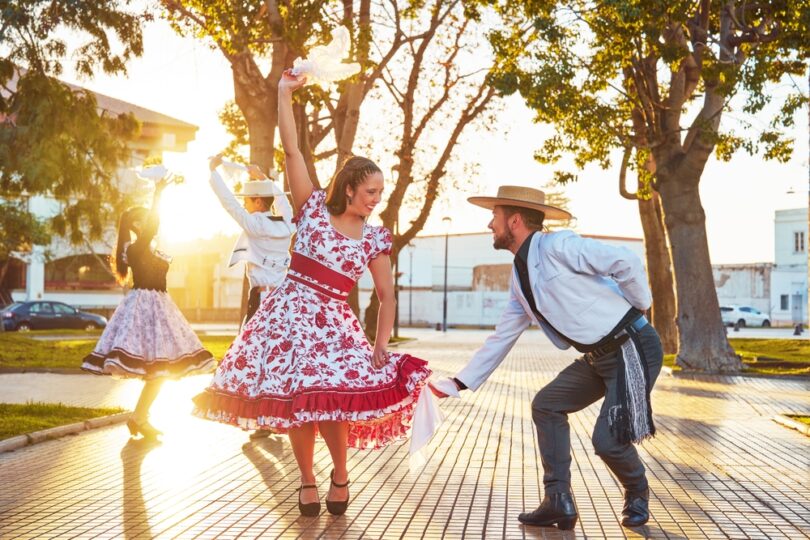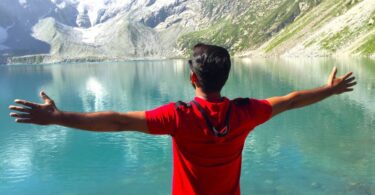Traveling is more than just visiting new places; it’s about immersing oneself in the cultures that enrich our world. As we journey through different landscapes, we often find that the truest essence of a destination lies not only in its landmarks and cuisine but also in its traditional art forms. Among these, dance is an immediate and accessible way to connect with the soul of a community.
Cultural dances encapsulate the stories, values, and histories of their people, often passed down through generations. They invite us to experience emotions that transcend language, allowing us to witness the pride, joy, and struggles of others through movement. From the rhythmic beats of Irish step dancing, which echo tales of both celebration and resilience, to the colorful twirls of India’s Bharatanatyam, conveying intricate narratives of spirituality and devotion, each dance form provides a distinctive window into the local culture.
United States — Square Dance

Western Square Dance Group by Deirdre licensed under CC BY-SA 3.0
Square dance is a lively and engaging folk dance that traces its roots back to 17th-century Europe, particularly in England and France, before making its way to the United States through early settlers. In the 19th century, it evolved into a distinctly American tradition, influenced by various regional styles and cultures. Square dancing often features four couples arranged in a square, moving in intricate patterns guided by a caller who provides instructions, alternating between traditional and contemporary music.
Today, square dance is celebrated for its sense of community and inclusiveness, bringing people of all ages together to engage in fun and lively interactions. Popular venues for square dancing can be found across the country, from small-town community centers to larger events like the National Square Dance Convention, which showcases this vivacious art form. In Reno, Nevada, the love for square dance thrives, with the city hosting the annual Nevada State Square Dance Festival, where dancers from across the region gather to celebrate this cherished folk tradition.
India — Bharatanatyam

Bharatanatayam
Bharatanatyam is one of the oldest classical dance forms of India, originating in Tamil Nadu, where it has been celebrated for over 2,000 years. This traditional dance was initially performed in temples, embodying religious beliefs while narrating stories from Hindu mythology through intricate footwork, expressive hand gestures, and emotive facial expressions.
In Tamil Nadu, around the Chennai area, numerous schools and institutions are dedicated to the preservation and promotion of Bharatanatyam. Festivals such as the Natyanjali Dance Festival held in Chidambaram attract dancers from all over the region and beyond, showcasing performances amidst the inspiring backdrop of temples.
Colombia — Cumbia

Cumbia
Cumbia is a traditional folk dance and music genre that originated on the Caribbean coast of Colombia. Its roots can be traced back to the African, Indigenous, and Spanish cultures that blended together over centuries, making Cumbia a vibrant reflection of Colombia’s diverse heritage. Featuring a lively rhythm often played with drums, flutes, and other traditional instruments, Cumbia is characterized by its infectious beats that invite participation and celebration.
Festivals celebrating Cumbia, such as the Festival de la Cumbia in El Banco, Magdalena, highlight the genre’s significance and bring communities together. Additionally, cities like Barranquilla host the famous Carnaval de Barranquilla, where Cumbia takes center stage alongside other folkloric dances.
Scotland — Highland Dance

Sword Dance
Highland Dance is a traditional dance form originating from Scotland in the United Kingdom, particularly associated with the Scottish Highlands. With roots that date back centuries, this dance genre is steeped in Scottish history and culture, often performed at gatherings, festivals, and competitions. Highland Dance is characterized by its energetic movements, intricate footwork, and athleticism, with dancers often performing in traditional Scottish attire, such as kilts and ghillie shoes.
These dances were historically performed during celebratory occasions, such as weddings and clan gatherings, and were used as a display of skill and strength. Among the most well-known Highland dances is the Highland Fling, a lively solo dance featuring quick footwork and precise timing, and the Sword Dance, where dancers perform intricate steps over crossed swords, symbolizing grace and precision. Today, Highland Dance is celebrated at various cultural events and competitions, including the prestigious Highland Games, where dancers showcase their talents in front of audiences that appreciate this vibrant art form.
Kenya and Tanzania — Maasai Adumu

Maasai Adumu by Brutere licensed under CC0 1.0
The Maasai Adumu, commonly known as the Jumping Dance, is a traditional dance performed by the Maasai people, who inhabit regions of southern Kenya and northern Tanzania. This dynamic and visually striking dance is an important cultural expression that showcases the strength, agility, and endurance of the Maasai warriors. During the Adumu, a group of dancers form a circle, and one or more dancers take turns jumping in the center. The dancers wear traditional Maasai attire, which includes bright shuka (cloaks) and beaded jewelry, contributing to the vibrant visual display. The jumps are accompanied by rhythmic singing and chanting, often led by the elder men or a designated leader, creating a communal atmosphere that emphasizes unity and celebration.
The Adumu not only serves as a form of entertainment but also has cultural significance, often performed during important ceremonies such as initiation rites, weddings, and community celebrations. It symbolizes courage, strength, and the readiness of young warriors to protect their community, making it a rite of passage.
Thailand — Khon

Khon
Khon is a traditional masked dance-drama in Thailand rooted in the Ramakien, the Thai adaptation of the Indian epic Ramayana. This elaborate performance art integrates dance, music, and drama, characterized by graceful movements, intricate costumes, and ornate masks. The theatrical nature of Khon involves actors performing choreographed movements to narrate stories from the Ramakien, often utilizing hand gestures to convey emotions and plot elements.
The costumes in Khon are visually stunning, adorned with gold and vibrant colors. Male characters typically don masks that cover their entire heads, while female characters tend to wear lighter makeup, allowing their facial features to show. Each mask is intricately designed to represent specific characters, ranging from gods to demons. The combination of aesthetics and symbolism in these costumes enhances the overall impact of the performance.
Spain — Flamenco

Flamenco
Flamenco is a passionate and expressive art form that originated in the Andalusian region of Spain, deeply rooted in the cultural history of the Romani people, as well as influences from Moorish, Jewish, and indigenous Andalusian traditions. This evocative performance style encompasses singing (cante), guitar playing (toque), dance (baile), and sometimes includes the use of handclaps (palmas) and castanets, creating a dynamic interplay of sound and movement.
Flamenco is traditionally performed in informal settings like taverns or private homes, creating a sense of intimacy and connection among performers and audiences. However, it has also found a place on international stages, where it is celebrated for its artistry and cultural significance. Flamenco is recognized by UNESCO as an Intangible Cultural Heritage of Humanity, underscoring its importance in Spain’s cultural identity and its continuing influence around the world.
You Might Also Enjoy: Art Discoveries: Small Museums with Surprisingly Famous Paintings
Philippines — Tinikling

Tinikling (Cabanatuan City) by Shubert Ciencia licensed under CC BY 2.0
Tinikling is a traditional Filipino dance that originated from the Visayan region, and is often performed during festivals and celebrations. Tinikling involves dancers skillfully maneuvering between two bamboo poles that are clapped together in a rhythmic pattern, requiring agility and precision. The dance is said to mimic the movements of the tikling bird, which is known for its ability to navigate through tall grass and bamboo, avoiding obstacles with grace.
The performance typically features pairs of dancers who alternate between jumping and stepping in and out of the spaces created by the bamboo poles. As the dancers move, they express joy and playfulness, often accompanied by lively traditional music. The coordination between the dancers and the rhythm of the clapping poles is vital, creating a captivating visual display that draws the audience’s attention. Costumes worn in Tinikling often reflect traditional Filipino attire, with colorful fabrics that enhance the overall presentation. The dance has also gained recognition outside of the Philippines, becoming a popular representation of Filipino culture in schools and cultural events around the world.
FAQs:
Q: Where can I see these dances performed?
A: Cultural dances are often showcased at dedicated festivals, cultural events, community gatherings, and theaters around the world. Check local event calendars, cultural centers, and social media for upcoming performances.
Q: Which of these dances can I participate in versus just watching?
A: Many dances, such as square dance, Tinikling, and Cumbia, are designed for participation. Others, like Bharatanatyam and Khon, are traditionally performed, but workshops may allow for audience involvement.
Q: Can I participate in dance festivals even if I’m a beginner?
A: Yes! Many festivals welcome dancers of all skill levels. Look for beginner workshops or community dance classes leading up to the event to build confidence before participating.
Q: Are there admission fees?
A: Admission fees can vary widely depending on the venue, event, and location. Some community events may be free, while larger festivals or performances may charge tickets. Check the event’s website for details.
Q: Are these dances family-friendly?
A: Yes, most cultural dances are family-friendly and encourage participation from all age groups. They often promote community engagement and can be a fun, educational experience for families.
Q: Where can I learn cultural dances like square dance and flamenco?
A: Many local community centers, dance schools, and cultural organizations offer classes in various cultural dances. Additionally, you can explore online platforms that provide virtual lessons to learn at your own pace.
Q: Are there online resources to learn more about these dances?
A: Yes, numerous online resources exist, including instructional videos, documentaries, and articles that delve into the history and techniques of various cultural dances. Websites like YouTube can be particularly useful.
Did we leave off your favorite cultural dance? Tell us about it in the comments below!







Leave a Comment